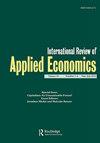Inequality growth within countries, despite catch-up between countries
IF 1.6
Q3 ECONOMICS
引用次数: 0
Abstract
The growth of China, India and other countries in the Global South over the past decades has led to a relative catching up with the already industrialised economies of North America and Europe. This translates into a reduction in global inequalities, in the sense that the gap between average living standards between the two categories of economy is no longer as great as it once was. However, this disguises what has been a global phenomenon of increased inequality of wealth and income within almost every country on earth. Thus, inequality has grown within China, within India, within the U.S., within the UK, and so on. So, any reference to reduced inequality globally needs to bear in mind this reality – of increased inequality facing people within their own country. In ‘Structural change and industrial linkages: a perspective on China’s growth pattern, 1995–2009’, Roberto Alexandre Zanchetta Borghi notes that ‘China has presented one of the most noticeable growth experiences in economic history’, with the high economic growth rates in the post-1978 reform era having been marked by deep structural changes. The paper analyses these changes from a Kaldorian-Structuralist perspective, emphasising ‘the importance of a large, diversified and integrated industrial base as a central engine of economic growth’ – which Borghi suggests, prevented balance-of-payments constraints, with most sectors having been able to generate through exports sufficient foreign exchange to pay for the required imports. In terms of the future for countries of the Global South – to go further in economic development, poverty reduction, and even perhaps reducing the inequalities in wealth and income that has been created over the past decades – an important role may be played by financial inclusion. In other words, ensuring that the less well off in these societies can gain access to basic financial products and services in a cost-effective matter. A review of the literature in this area, regarding the factors responsible for financial exclusion, policy initiatives by government and regulatory bodies, and recent trends regarding financial inclusion, is reported by Anusha Goel, in ‘Trends and reforms of financial inclusion in India’. While the literature does report progress in many aspects, as far as India is concerned, the overall picture is one of work in progress, with various challenges still faced, and needing to be overcome. Along with financial inclusion, development requires an effective productive infrastructure – including transport, communications, energy, and water and hygiene. This aspect is analysed by Isaac Ketu and Paul Ningaye in ‘Does Infrastructure Development Matter for the Shadow Economy in African Countries?’. Analysing 42国家内部的不平等增长,尽管国家之间有所追赶
过去几十年来,中国、印度和全球南方其他国家的增长相对赶上了北美和欧洲已经工业化的经济体。这意味着全球不平等现象的减少,因为这两类经济体的平均生活水平之间的差距不再像以前那么大。然而,这掩盖了世界上几乎每个国家财富和收入不平等加剧的全球现象。因此,中国、印度、美国、英国等国的不平等现象日益严重。因此,任何提及全球不平等现象减少的说法都需要考虑到这一现实——本国人民面临的不平等加剧。Roberto Alexandre Zanchetta Borghi在《结构变化和产业联系:1995-2009年中国增长模式的视角》一书中指出,“中国呈现了经济史上最引人注目的增长经历之一”,1978年后改革时代的高经济增长率标志着深刻的结构变化。本文从卡尔多林结构主义的角度分析了这些变化,强调了“大型、多样化和一体化的工业基础作为经济增长的中心引擎的重要性”——Borghi认为,这防止了国际收支限制,大多数部门都能够通过出口产生足够的外汇来支付所需的进口。就全球南方国家的未来而言——要在经济发展、减贫方面走得更远,甚至可能减少过去几十年中造成的财富和收入不平等——金融包容性可能会发挥重要作用。换言之,确保这些社会中不太富裕的人能够获得基本的金融产品和服务,这是一件具有成本效益的事情。Anusha Goel在《印度金融包容性的趋势和改革》一书中报告了这一领域的文献综述,涉及金融排斥的因素、政府和监管机构的政策举措以及金融包容性的最新趋势。虽然文献确实报道了许多方面的进展,但就印度而言,总体情况是正在进行的工作,仍面临各种挑战,需要克服。除了金融包容性,发展还需要有效的生产性基础设施,包括运输、通信、能源、水和卫生。Isaac Ketu和Paul Ningaye在《基础设施发展对非洲国家的影子经济重要吗?》中分析了这一方面。分析42
本文章由计算机程序翻译,如有差异,请以英文原文为准。
求助全文
约1分钟内获得全文
求助全文
来源期刊

International Review of Applied Economics
ECONOMICS-
CiteScore
4.30
自引率
4.50%
发文量
37
期刊介绍:
International Review of Applied Economics is devoted to the practical applications of economic ideas. Applied economics is widely interpreted to embrace empirical work and the application of economics to the evaluation and development of economic policies. The interaction between empirical work and economic policy is an important feature of the journal. The Journal is peer reviewed and international in scope. Articles that draw lessons from the experience of one country for the benefit of others, or that seek to make cross-country comparisons are particularly welcomed. Contributions which discuss policy issues from theoretical positions neglected in other journals are also encouraged.
 求助内容:
求助内容: 应助结果提醒方式:
应助结果提醒方式:


